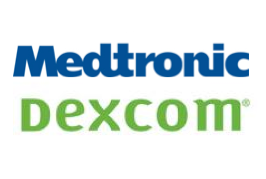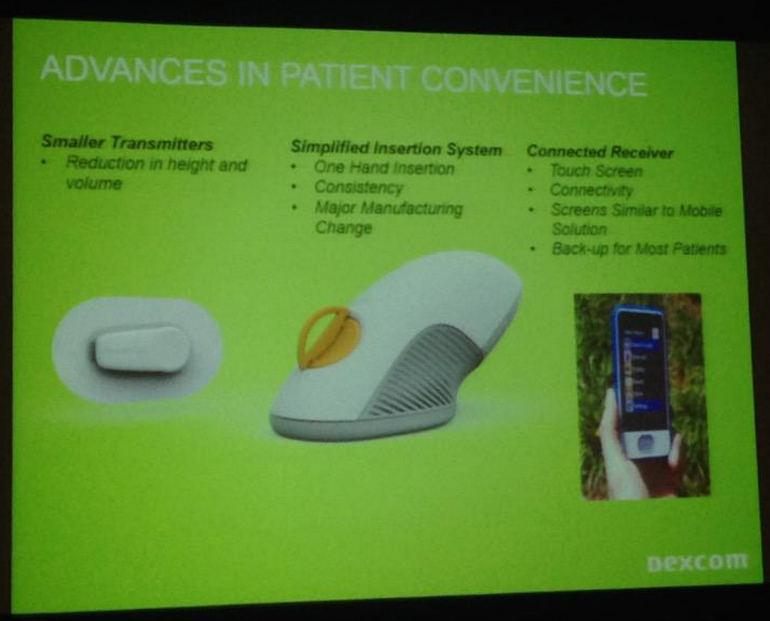What’s Coming in CGM Technology in 2016 and Beyond?
By Adam Brown
 by Adam Brown and Alexander Wolf
by Adam Brown and Alexander Wolf
Dexcom’s new insertion, Android G5, touchscreen receiver; Medtronic’s Android MiniMed Connect, Hypo Prediction App, 670G, and Guardian Connect.
Dexcom and Medtronic’s recent quarterly update calls shared new timing details on their latest continuous glucose monitoring (CGM) products – our team listens to all these calls and we wanted to give you a “what’s what!” update. Read below for specifics on the CGM upgrades, which will improve the experience of wearing CGM on many fronts: less pain and hassle, more convenience, Android compatibility, and greater accuracy and reliability.
Dexcom may launch five products this year: a new one-button insertion system; a new touchscreen receiver; a smaller transmitter; an Android version of the G5 mobile app; and an enhanced version of the G5 mobile app that shows insulin-on-board data.
Medtronic has plans to launch at least two CGM products this year: an Android version of MiniMed Connect before June and a hypoglycemia prediction app this summer. Two future products will also be sent to FDA for review this year, meaning they could launch in early 2017 (the MiniMed 670G/Enlite 3 hybrid closed loop and the Guardian Connect mobile CGM). More details below!
DEXCOM
-
 Dexcom plans to launch a new one-button insertion system by the end of 2016. Feedback on the new design has been “remarkable” and the process sounds much simpler: (i) peel tape; (ii) put on skin; and (iii) push one button to insert the sensor. This will be a significant upgrade from the current syringe-like design, which is hard to do with one hand and intimidating for many patients.
Dexcom plans to launch a new one-button insertion system by the end of 2016. Feedback on the new design has been “remarkable” and the process sounds much simpler: (i) peel tape; (ii) put on skin; and (iii) push one button to insert the sensor. This will be a significant upgrade from the current syringe-like design, which is hard to do with one hand and intimidating for many patients. -
A new Dexcom touchscreen receiver will also launch by the end of 2016. It will be less susceptible to wear than the current receiver, and it will also offer a user interface in line with the G5 mobile app. In the past, management has said the new receiver will include Wi-Fi, though we recently learned the new receiver will not include Wi-Fi at launch.
-
An ~50% smaller G5 transmitter will also launch in 2016 alongside the new insertion system, though this information was not mentioned in the February call.
-
An Android version of the G5 mobile app is still expected to launch this year, supporting the major Android phone brands (e.g., Samsung). G5 is currently only available for patients with Apple (iOS) devices, meaning this upgrade could really expand availability. See our test drive on G5 for more info.
-
An enhanced version of the G5 Mobile app may also launch this year, including “additional features and functionality.” The call mentioned showing insulin-on-board data from pump partners, which could include Insulet, Bigfoot Biomedical, Tandem, and Animas in the future.
-
The FDA may potentially approve an insulin-dosing claim before the end of the year. This approval is critical for Medicare coverage and important for getting more patients to try CGM. Many current Dexcom users dose insulin based only on the real-time CGM reading (without a fingerstick confirmation), though the product is not actually FDA-approved for doing so.
-
A pivotal study of the next-generation “G6” sensor will begin before mid-2016, which could enable a launch in late 2017 or early 2018 if all goes well. The G6 sensor will feature 10-day wear, one fingerstick calibration per day (compared to twice-daily with the G4-G5), and overall better accuracy and reliability.
-
Dexcom released an updated version of the G5 app that includes Apple Watch compatibility and an option to view CGM data directly on the iPhone lock screen (called a “today widget”; see the images on the G5 App store page). These updates address the first two criticisms we had in our G5 test drive last fall, and both help achieve one key goal: showing critical CGM information (value, trend arrow, three-hour graph) without unlocking the phone.
MEDTRONIC
-
.jpg) Medtronic will submit its Bluetooth-enabled Guardian Connect mobile CGM to the FDA in early March, with launch expected by April 2017. The product will launch in Europe this summer. Guardian Connect sends CGM data directly from the on-body transmitter to an iPhone app via Bluetooth – no pump or receiver required. This is similar to Dexcom’s G5 and Abbott’s LibreLink (Sweden-only), and opens up Medtronic CGM to those not on pumps. Guardian Connect will use the more accurate Enlite 3 sensor. The current MiniMed Connect app does receive Medtronic CGM data, though it requires a key-fob sized “relay” device to receive data from the pump.
Medtronic will submit its Bluetooth-enabled Guardian Connect mobile CGM to the FDA in early March, with launch expected by April 2017. The product will launch in Europe this summer. Guardian Connect sends CGM data directly from the on-body transmitter to an iPhone app via Bluetooth – no pump or receiver required. This is similar to Dexcom’s G5 and Abbott’s LibreLink (Sweden-only), and opens up Medtronic CGM to those not on pumps. Guardian Connect will use the more accurate Enlite 3 sensor. The current MiniMed Connect app does receive Medtronic CGM data, though it requires a key-fob sized “relay” device to receive data from the pump. -
An FDA submission for the MiniMed 670G/Enlite 3 hybrid closed loop system is targeted before the end of June, meaning a launch by April 2017 is still possible. Enrollment in the US pivotal study will complete in the “next few weeks,” which is slightly different from Dr. Fran Kaufman’s expectation at ATTD that the trial would end in late February. More than 75% of trial participants continue to use the system as part of the FDA’s continued access program – that’s a strong vote of confidence that patients really like the device.
-
An Android version of the MiniMed Connect app will be available before this June, the first timing ever shared. The current MiniMed Connect app requires a patient to have an Apple (iOS) device, so this update will expand availability to more patients. As noted above, Dexcom also plans to launch an Android version of G5 this year.
-
The update call did not mention it, but Medtronic has previously announced plans to launch a hypoglycemia prediction app with IBM Watson this summer. Read here for more information on that exciting partnership.







